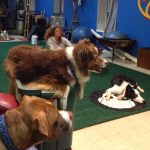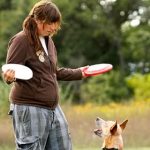
Pawsitive Vybe S2E7 – The Mystery Show
Playing disc with your dog is just dog training – The behavior chains are longer and things move a bit faster but it’s still just dog training.
Dog training is a dialogue. A big part of your job is to recognize and answer the questions your dog asks. Make sure your goal of getting the behavior does not get in the way of learning and good communication.
Pawsitive Vybe is a weekly 1/2 hour dog training & lifestyle webseries on YouTube that is seeking wider distribution and production support. It is self produced by Ron Watson of Pawsitive Vybe.
Dog training is a dialogue. The quality of which is dependent upon the understanding of the concepts involved.
1:34 – Perch on Paw Pods with Loot
1:10 – Plan B: Hoop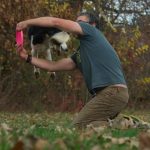 A Hoop is an Over or Vault that travels through a hoop made from your arms or body. A Hoop expresses great teamwork and connection between dog and handler. Most Hoops are done... More and Bound
A Hoop is an Over or Vault that travels through a hoop made from your arms or body. A Hoop expresses great teamwork and connection between dog and handler. Most Hoops are done... More and Bound
2:53 – Show Intro
6:03 – RunnersA Runner is a disc that is thrown without the intent to float or hover around a target. It’s just a normal run of the mill distance throw. Runners are not likely to... More & Floaters
8:59 – Backchaining a Spot with Loot
13:05 – Vault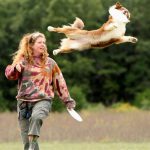 The dog uses the player´s body as a launching pad to jump for a disc. A Vault is a leaping catch from the handler’s body. The dog leaves the ground for the target... More Basics & New Vault with Hops
The dog uses the player´s body as a launching pad to jump for a disc. A Vault is a leaping catch from the handler’s body. The dog leaves the ground for the target... More Basics & New Vault with Hops
16:13 – Backer Shout Out
17:15 – Zig Zag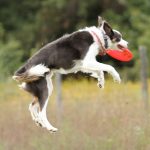 A Zig Zag is a series of catches in smooth succession that forces the dog to move back and forth across the field. Usually performed at a distance of 8-20 yards, the Zig... More for Big Leaping
A Zig Zag is a series of catches in smooth succession that forces the dog to move back and forth across the field. Usually performed at a distance of 8-20 yards, the Zig... More for Big Leaping
19:19 – Creative Runners & Floaters
21:21 – Backchaining Duration
25:38 – Flatwork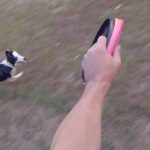 Flatwork is the stuff that happens between the catches. How the team moves and transitions, often without the disc, is flatwork. Flatwork concepts in disc dog are taken from the agility and herding... More & Leaping with Loot
Flatwork is the stuff that happens between the catches. How the team moves and transitions, often without the disc, is flatwork. Flatwork concepts in disc dog are taken from the agility and herding... More & Leaping with Loot
27:59 – Show Close
Leveraging Concepts
There is a dialogue in positive dog training that most people are not aware of. Once your dog has some concepts under their belt and at the top of their brain, they will ask questions about them. “Hey this looks like a Threshold… Is this a ThresholdA dog’s working state can be said to be over or under Threshold. A dog that is over Threshold has trouble working. A dog that is under Threshold is in good shape to... More?” “Hey, I’m standing here and you didn’t ask me off… you going to do that?”
Astute dog trainers will answer that question, but many dog trainers don’t even notice that a question was asked because they are too focused on their criteria, rate of reinforcement, or the behavior at hand. This dialogue is a powerful piece of positive dog training.
While successive approximation in shaping is well understood – like a game of hot and cold – getting closer and closer to the behavior you want – that is not all shaping is. It is not even the powerful part. The real power of shaping is leveraging the concepts that are teased out of this dialogue between dog and handler that create those “Aha!” or “Eureka!” moments.
The Case for Plan B – Capitalize on Cool Mistakes
In the first working segment of the show (1:10), Hops and I are working on cleaning up and generalizing the Hoop behavior. He runs and jumps through a hoop made from my arms. He’s solid in one direction, but from the other he’s not very solid. Hops offered a rebound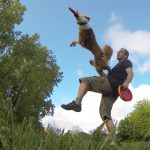 A Reverse Vault is a vault in which the dog flips off the handler’s body. The Reverse Vault, aka Rebound, can be done off of any part of the body, and the part... More, or a fakie type vault off of my body during the weak side performance of the hoop. It was pretty cool, so I stuck with it.
A Reverse Vault is a vault in which the dog flips off the handler’s body. The Reverse Vault, aka Rebound, can be done off of any part of the body, and the part... More, or a fakie type vault off of my body during the weak side performance of the hoop. It was pretty cool, so I stuck with it.
A bunch of my signature disc dog moves and dog training tactics developed from Plan B type situations.
A big part of doing super cool things with dogs is having the presence of mind to realize when something that may be a mistake is cool and having the confidence and clarity to shift gears and focus in on it and create something totally new and unique.
Contrasting Correlated Skills
Once Hops offered the poorly performed Hoop, and I went to Plan B and cued the ‘bound I fell right into one of our basic training tenets – purposefully contrasting similar skills or skills that the dog may be conflating or mixing up during the heat of performance.
Spin and Twist is a common situation – spin clockwise and spin counter clockwise in front of the handler. Many handlers will only work at a time: spin, spin, spin, spin – Go do dog stuff. And then: twist Spins and Twists are tricks where the dog spins 360 degrees in a clockwise or counter clockwise fashion. Spin is clockwise and Twist is counter clockwise so it is important to have a... More, twist, twist, twist – Go do dog stuff. The rationale behind this is that you don’t want to confuse the dog and that you want to work one skill at a time.
Spins and Twists are tricks where the dog spins 360 degrees in a clockwise or counter clockwise fashion. Spin is clockwise and Twist is counter clockwise so it is important to have a... More, twist, twist, twist – Go do dog stuff. The rationale behind this is that you don’t want to confuse the dog and that you want to work one skill at a time.
Well, Spin and Twist are very closely related and they exclude each other. When this situation presents itself, the most efficient path to discriminating them and teaching them is to put them right next to each other from the get go. This way they become the same skill only in a different direction. The cues look similar and are generalized on the fly. Everything makes sense and paints a simple picture.
Teaching them one at a time means that it is likely to be confusing for the dog because there is not that common thread. The handler will have to teach both, like from scratch, and then have to do the generalization afterwards anyway. This is a missed opportunity to teach the continuity of the skills, their correlation, and their exclusive nature.
Contrasting similar skills is good dog training.
Back Chaining
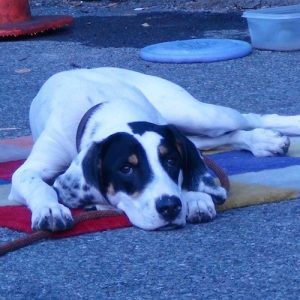 This episode features a few Back chaining sessions. Backchaining is teaching the last part of the skill first, reinforcing the heck out of it so it is nearly guaranteed to happen, and then adding in, or just expecting the behaviors that come before it to happen.
This episode features a few Back chaining sessions. Backchaining is teaching the last part of the skill first, reinforcing the heck out of it so it is nearly guaranteed to happen, and then adding in, or just expecting the behaviors that come before it to happen.
Marking and reinforcing the Off behavior, for instance, means that getting on part has to happen before the dog can make the Off part pay out. So you can teach a dog to jump up on an object and wait there just by reinforcing the Off part. In the case of the Backchaining the Spot with Loot (8:59), we didn’t even touch the On behavior at all. This is such a slick way to train so many behaviors.
Back chaining is a great way to teach long behavior chains or behavior chains that your dog doesn’t understand completely. Front Front is a stable position directly in front of the handler. Front is an traditional obedience skill. Usually your dog sits in this position, but standing is often acceptable as well, especially in... More chaining, building the behavior from beginning to end, means that the dog has to understand each step of the behavior, all criteria must be understood or taught in order for the behavior to be assembled. You are walking up the steps of the behavior. It tends to get harder and harder to balance the higher you get.
Front is a stable position directly in front of the handler. Front is an traditional obedience skill. Usually your dog sits in this position, but standing is often acceptable as well, especially in... More chaining, building the behavior from beginning to end, means that the dog has to understand each step of the behavior, all criteria must be understood or taught in order for the behavior to be assembled. You are walking up the steps of the behavior. It tends to get harder and harder to balance the higher you get.
Back chaining is just the opposite. Instead of building the behavior, up, up, up a ladder… you are falling into the behavior. It’s a trap or a descending spiral that always winds up finishing in the same place.
Back chaining is fast and elegant. The only problem with it is that sometimes the behavior winds up performed without any understanding of how it works.
Chronology of Cuing – Verbal Then Physical
When you cue your dog, you want to ensure that you give the verbal cue before the physical. Don’t give the verbal and physical cues at the same time. It totally fries your dog’s little brain. It’s like a short circuit, or an overloaded circuit. They can’t seem to process both cues at once.
Generally speaking, when using a redundant cue – verbal + physical cue or situation + physical cue – you want to give the weak cue before you give the stronger cue. If you find your dog balking on cues frequently check to make sure you are giving clear and distinct cues in a proper chronological order.
Discussion in Comments Below
I’ll do my best to answer any and all questions on the show, Attention/Dismissal or Targeting, or the Threshold concept in the comments below. Don’t be shy, the only silly questions are the ones not asked.









